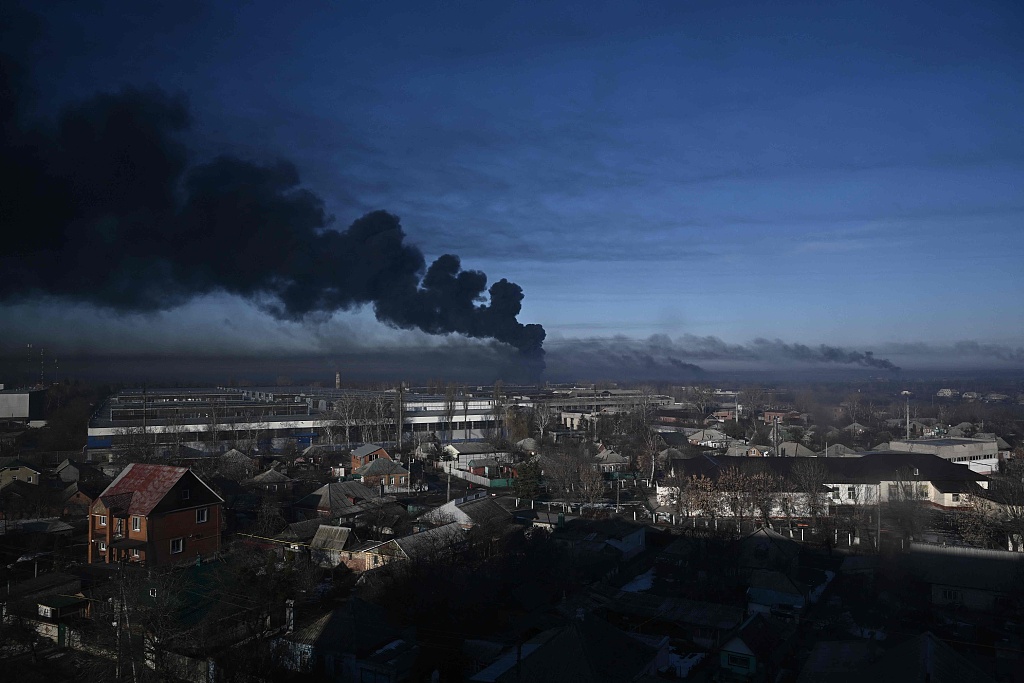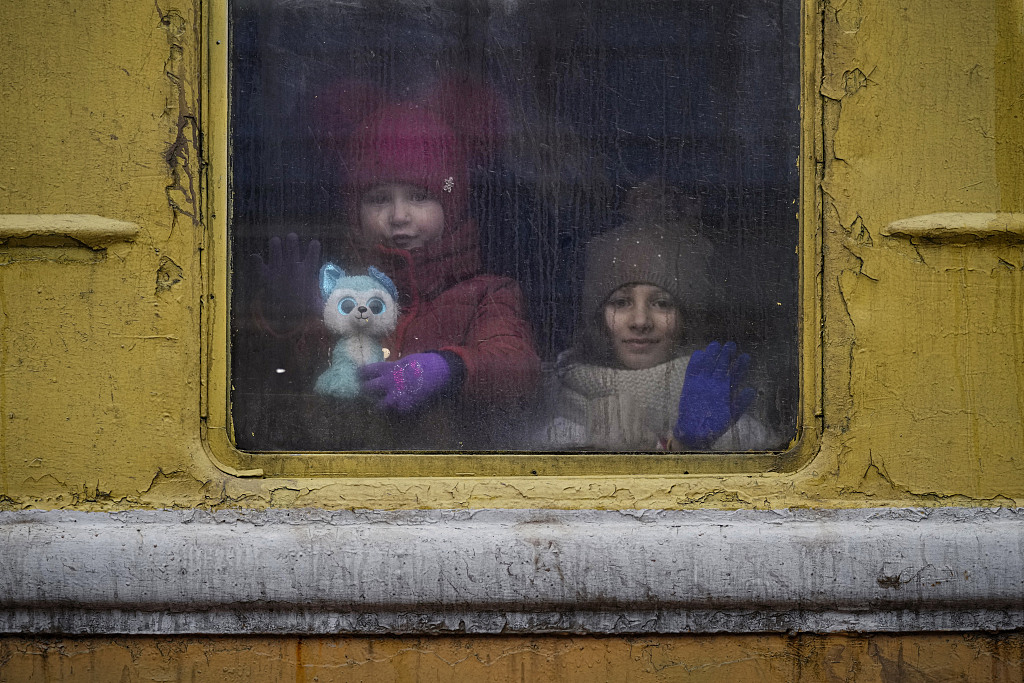
On February 24, 2022, local time, in Kharkov, Ukraine, black smoke rose from a military airport in Chuguyev near Kharkov. Russian President Vladimir Putin announced military action against Ukraine on February 24, 2022, and then explosions were heard all over the country. Vision china diagram
On February 24, 2022, the Ukrainian crisis suddenly escalated. Looking back on this year, people deeply feel the impact of this crisis on the world.
Over the past year, what has changed is not only the jagged confrontation front, but also NATO’s aid to Ukraine from protective helmets to main battle tanks, and the increasing number of casualties every day, as well as the European economy that is constantly losing blood, the doubled electricity and flour bills of Hungarian bakeries, and the high feed price faced by Tunisian farmers … … This "the largest military conflict in Europe since the 21st century" has brought severe global security challenges, drastic geopolitical changes and extensive economic and social impacts, far exceeding expectations.
Over the past year, more and more people of insight in the world have realized that the United States is clinging to unilateralism, hegemonism and the Cold War mentality, playing geopolitical games under the banner of ideology, and its various bad actions are fundamentally shaking world peace and stability. When the world is in turmoil and intertwined, only by adhering to peace, development, cooperation and win-win, replacing division with unity, confrontation with cooperation and exclusion with tolerance, is the correct way for human society to overcome the difficulties together.

On March 3, 2022, in Kiev, the capital of Ukraine, children looked out of the window on a train bound for Lviv. Vision china diagram
The security situation is even more severe.
Artillery, tanks, drones, smoke, ruins, refugees … … Similar images are scrolled on TV and social media almost every day, telling the world that the intensity of this conflict has not diminished with the passage of time. On the contrary, the western countries led by the United States are trying their best to defeat Russia, and the global security situation is facing the risk of spiral deterioration.
Under the leadership of the United States, NATO continued to send weapons and equipment to Ukraine, providing personnel training and intelligence support, which constantly fueled the crisis. Since the Biden administration came to power, the total amount of military assistance promised by the United States to Ukraine has reached $30 billion. From the initial provision of non-lethal military equipment such as helmets to the provision of lethal weapons such as individual anti-tank missiles, to the provision of heavy weapons such as armored vehicles and self-propelled artillery, recently, it promised to provide main battle tanks and began to discuss the provision of offensive weapons such as fighter jets. The western aid to the Ukrainian army has been continuously upgraded. NATO has continuously strengthened its military deployment in the surrounding areas of Russia, such as Eastern Europe and the Baltic countries, actively recruited Sweden and Finland into the treaty, and NATO member countries such as Germany, France and Denmark have substantially increased their defense expenditures. These actions are constantly stimulating Russia’s security nerves.
In the view of Hungarian Prime Minister Orban, Europe "has actually indirectly fought with Russia", "We will soon hear the so-called ‘ Peacekeeping forces ’ This kind of thing. " Fyodor Lukjanov, research director of the Valdai International Debate Club in Russia, believes that the supply of tanks by the West to Ukraine is likely to lead Russia and NATO to the brink of direct conflict. In an interview with Tass news agency, Russian Foreign Minister Lavrov also warned that western policies aimed at comprehensively containing Russia are extremely dangerous and may lead to direct armed conflicts between nuclear powers.
In response to western military pressure, Russia is also stepping up its military strength and demonstrating its strategic deterrent capability. On the one hand, the Russian army increased its attack on the military, communications and energy infrastructure of Ukraine in order to undermine the potential of the Ukrainian war. On the other hand, Russia has expanded its military strength through partial mobilization, and plans to carry out large-scale adjustment from 2023 to 2026, expanding the number of troops to 1.5 million, and at the same time strengthening equipment supply guarantee and infrastructure construction to meet national defense needs.
The reason why this crisis has reached this stage lies in the fact that NATO, led by the United States, sticks to the Cold War mentality, indulges in zero-sum games and is keen on camp confrontation, trying to weaken Russia to the maximum extent through "proxy war". "With the closure of the dialogue channel, the artillery became a megaphone." Pan Kajie Mishra, a columnist of Bloomberg News, wrote that the escalating military assistance from the United States and Europe to Ukraine has opened a "dangerous new era" in global politics.

On March 25th, 2022, in Kharkov, Ukraine, after an attack, a man searched for items from a burning shop. Vision china diagram
Geopolitical map remodeling
As Mishra said, the escalation of the Ukrainian crisis profoundly reshaped the global geopolitical pattern.
The confrontation between the west and Russia, led by the United States, has intensified. Fu Limin, a former US Assistant Secretary of Defense and senior diplomat, said in an interview with Xinhua News Agency a few days ago that US President Biden repeatedly stressed that the US supports Ukraine "as long as it takes". If Biden’s meaning is consistent with that of US Secretary of Defense Austin, that is, the main goal of the United States is to weaken and isolate Russia, then this goal will not only be achieved, but also lead to a series of negative consequences. If the bloody conflict continues for a long time, it will not be good for Europe, Russia, Ukraine and the United States.
There is a growing rift between Europe, which has been hit, and the United States, which is profiting from it. At the beginning of the escalation of the Ukrainian crisis, Europe and the United States showed a gesture of "unity", but soon Europe strongly felt the anti-itself effect brought by sanctions against Russia: energy prices soared, prices rose sharply, and people complained. The United States not only sold energy and arms to Europe at high prices, but also enacted the Inflation Reduction Act and the Chip and Science Act of 2022, which contained huge industrial subsidies and overbearing provisions to curb competition, seriously hurting European interests and causing strong dissatisfaction among European countries. Michele Geraci, former Italian Deputy Minister of Economic Development, said that NATO’s eastward expansion under the leadership of the United States is one of the root causes of the escalation of the Ukrainian crisis, and the cost of the crisis is mainly borne by Europe.
Most developing countries refuse to take sides and show their willingness to be independent. The US government once pressured Saudi Arabia, the United Arab Emirates and other allies in the Middle East to increase oil production to lower international oil prices, and cooperated with Western sanctions against Russia, resulting in a cold reception. At the 59th Munich Security Conference held a few days ago, the leaders of the United States and other western countries trumpeted the "Russian threat theory", which was refuted by developing countries. Colombian Vice President Francesca Marquez said: "We don’t want to continue to discuss who will win or lose the war. We are all losers. " The Financial Times website pointed out that some leaders in African and South American countries were obviously disappointed. They believed that the Ukrainian crisis consumed time, money and attention at the expense of other pressing issues.
In fact, developing countries are increasingly dissatisfied with the western-led international order. The Munich Security Report 2023 released by the Mu An Conference pointed out that the escalation of the Ukrainian crisis has brought challenges to the international order, and many Asian, African and Latin American countries have "reasonable dissatisfaction" with the existing international order. Such dissatisfaction needs to be respected and the world needs to reshape the vision of the international order.

On June 15th, 2022, local time, in Donbass region, Ukrainian soldiers opened fire on Russian positions on the front line of Donbass region in eastern Ukraine with a French Caesar gun of 155 mm /52 times caliber. Vision china diagram
Spillover effects spread all over the world
Faced with the double price of tomatoes, rice, eggs and other foods, Egyptian garbage collector Abdarrahman had to find a part-time job at night to support three children; Meria, a small Tunisian farmer, could not afford the surge in the cost caused by the surge in feed prices and had to sell one-third of his livestock to reduce losses; Margit, a Hungarian bread shop owner, watched the natural gas bill rise more than six times and his business was in trouble … … The escalation of the Ukrainian crisis, especially the severe western sanctions against Russia, has had a major impact on the economic and social fields of various countries, and the spillover effect has spread all over the world.
On the economic level, the prices of food, energy and other commodities have risen, which has aggravated global inflation. Russia is a major producer of oil and natural gas in the world. Many rounds of western sanctions against Russia interfered with and destroyed the market mechanism, which led to a record high in European natural gas prices. Russia and Ukraine are both major grain exporters, and the conflict has blocked the exports of the two countries. In particular, the western countries set up "hidden barriers" against Russian agricultural products exports, which caused Russian exporters to be "stuck in the neck" in many links, and international food prices fluctuated greatly. According to the data of the Food and Agriculture Organization of the United Nations, in 2022, a total of about 205 million people in 45 countries and regions were in a state of "crisis" or more serious food insecurity, with a significant increase over the previous year. According to the latest data of the International Monetary Fund, the global inflation rate was 8.8% in 2022, much higher than 4.7% in 2021. The inflation rates in the United States, Europe and Japan are all at high points in decades, and the inflation situation in some emerging markets and developing economies such as Turkey and Argentina is even more severe.
On the social level, the escalation of the Ukrainian crisis triggered a new wave of refugees, which also aggravated the global poverty problem. Over the past year, millions of refugees have fled Ukraine, forming the largest refugee tide in Europe since World War II, crowding out public resources such as housing, education and medical care in European countries, making the finances of these countries overwhelmed and posing a severe test to their social security and coordination capabilities. From a global perspective, high food prices have the most serious impact on the poorest people in the world. According to the World Bank’s estimation, for every 1% increase in food prices, 10 million people in the world will fall into extreme poverty. The intensification of inflation is also intensifying social contradictions in many countries, and protests and riots caused by the decline in purchasing power occur from time to time.

On November 13th, 2022, local time, members of a Ukrainian family were reunited for the first time since Russian troops withdrew from Hellson. Vision china diagram
At present, the Ukrainian crisis has no signs of calming down, and the spillover effect on the world economy and society will continue. Georgieva, managing director of the International Monetary Fund, said that the Ukrainian crisis was the "biggest negative factor" facing the world economy in 2022, and it may be the same in 2023.
劝和促谈方为正道
乌克兰危机负载着上世纪冷战遗留的历史问题,凸显当下百年大变局中的复杂博弈。
世界又一次站在历史的十字路口。
中国对冲突扩大化、长期化感到担忧。一年来,中国始终站在和平一边,站在对话一边,倡导共同、综合、合作、可持续的安全观,为推动局势降温、尽早实现停火止战和避免人道主义危机作出努力。
回顾中方历次表态,劝和促谈始终是关键词,呼吁理性冷静一以贯之。
从冲突发生的第二天起,习近平主席就提议通过对话寻求政治解决争端。习近平主席明确指出,冲突战争没有赢家,复杂问题没有简单答案,大国对抗必须避免。他多次同法国、德国、美国等国领导人和欧盟等区域组织负责人通话,清晰阐明在乌克兰问题上的立场主张:“各国主权、领土完整都应该得到尊重,联合国宪章宗旨和原则都应该得到遵守,各国合理安全关切都应该得到重视,一切有利于和平解决危机的努力都应该得到支持”,“要坚持劝和促谈”“要防止出现更大规模人道主义危机”“要构建欧洲和亚欧大陆持久和平”“要防止局部冲突扩大化”。
2022年4月,习近平主席提出全球安全倡议,为应对国际安全挑战、实现世界长治久安提出中国方案,在国际上获得广泛认同与支持。日前,中国政府发布《全球安全倡议概念文件》,为解决全球安全难题提供更系统的思路、更可行的举措。
巴基斯坦总理夏巴兹·谢里夫说,全球安全倡议倡导协同合作的发展方式,这超越了通过强权竞争与军备竞赛来实现自身安全最大化的零和思维。印尼智库亚洲创新研究中心主席班邦·苏尔约诺表示,不同于某些西方国家片面追求自身安全的思维,中国提出的全球安全倡议追求的是共同安全,是强调和平、合作的安全观,有利于建立相互尊重、平等互信的国际秩序,对人类实现持久和平与长远发展具有重要意义。
观察人士指出,人类社会绝不能重走阵营对立、分裂对抗的老路,绝不能陷入零和博弈、战争冲突的陷阱。建设一个更加安全的世界,是各国人民的强烈愿望,是世界各国的共同责任,更是时代前进发展的正确方向。全球安全倡议所倡导的理念主张,所提出的“支持通过对话谈判政治解决乌克兰危机等热点问题”的具体路径,为化解危机、维护世界和平稳定提供了重要指引。



